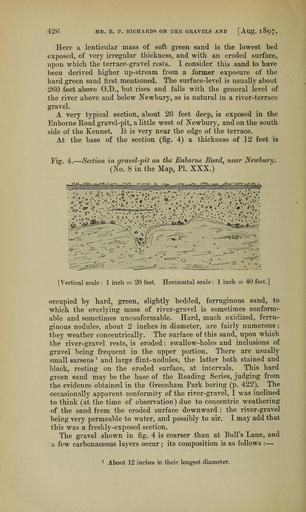MAKE A MEME
View Large Image

| View Original: | The_Quarterly_journal_of_the_Geological_Society_of_London_(12893618455).jpg (1220x2042) | |||
| Download: | Original | Medium | Small | Thumb |
| Courtesy of: | commons.wikimedia.org | More Like This | ||
| Keywords: The Quarterly journal of the Geological Society of London (12893618455).jpg 426 ME E P RICHARDS ON THE GRAVELS AND Aug 1897 <br> Here a lenticular mass of soft green sand is the lowest bed <br> exposed of very irregular thickness and with an eroded surface <br> upon which the terrace-gravel rests I consider this sand to have <br> been derived higher up-stream from a former exposure of the <br> hard green sand first mentioned The surface-level is usually about <br> 260 feet above O D but rises and falls with the general level of <br> the river above and below Newbury as is natural in a river-terrace <br> gravel <br> A very typical section about 26 feet deep is exposed in the <br> Enborne Road gravel-pit a little west of Newbury and on the south <br> side of the Kennet It is very near the edge of the terrace <br> At the base of the section fig 4 a thickness of 12 feet is <br> J ig 4 ” Section in gravel-pit on the Enborne Road near Newbury <br> No 8 in the Map PI XXX <br> Vertical scale 1 inch 20 feet Horizontal scale 1 inch 40 feet <br> occupied by hard green slightly bedded ferruginous sand to <br> which the overlying mass of river-gravel is sometimes conform- <br> able and sometimes unconformable Hard much oxidized ferru- <br> ginous nodules about 2 inches in diameter are fairly numerous <br> they weather concentrically The surface of this sand upon which <br> the river-gravel rests is eroded swallow-holes and inclusions of <br> gravel being frequent in the upper portion There are usually <br> small sarsens and large flint-nodules the latter both stained and <br> black resting on the eroded surface at intervals This hard <br> green sand may be the base of the Reading Series judging from <br> the evidence obtained in the Greenham Park boring p 422 The <br> occasionally apparent conformity of the river-gravel I was inclined <br> to think at the time of observation due to concentric weathering <br> of the sand from the eroded surface downward the river-gravel <br> being very permeable to water and possibly to air I may add that <br> this was a freshly-exposed section <br> The gravel shown in fig 4 is coarser than at Bull's Lane and <br> a few carbonaceous layers occur ; its composition is as follows ” <br> 1 About 12 inches in their longest diameter 36029249 111130 51125 Page 426 Text 53 http //www biodiversitylibrary org/page/36029249 1897 Geological Society of London Biodiversity Heritage Library The Quarterly journal of the Geological Society of London v 53 1897 Geology Periodicals Smithsonian Libraries bhl page 36029249 dc identifier http //biodiversitylibrary org/page/36029249 smithsonian libraries Information field Flickr posted date ISOdate 2014-03-03 Check categories 2015 August 26 CC-BY-2 0 BioDivLibrary https //flickr com/photos/61021753 N02/12893618455 2015-08-26 16 58 31 cc-by-2 0 PD-old-70-1923 The Quarterly journal of the Geological Society of London 1897 Photos uploaded from Flickr by Fæ using a script | ||||